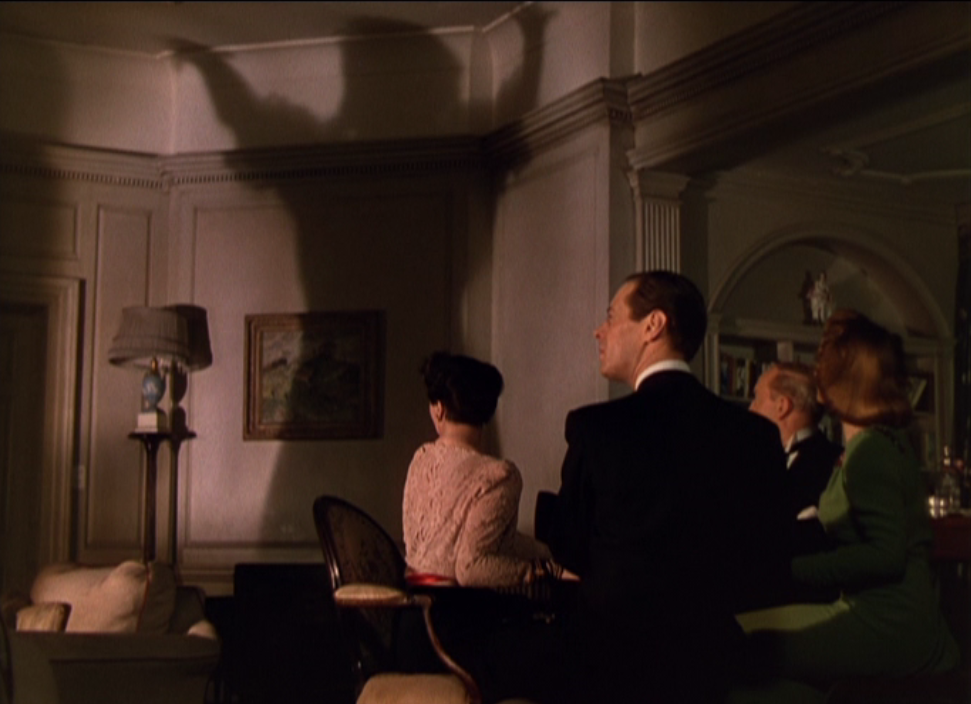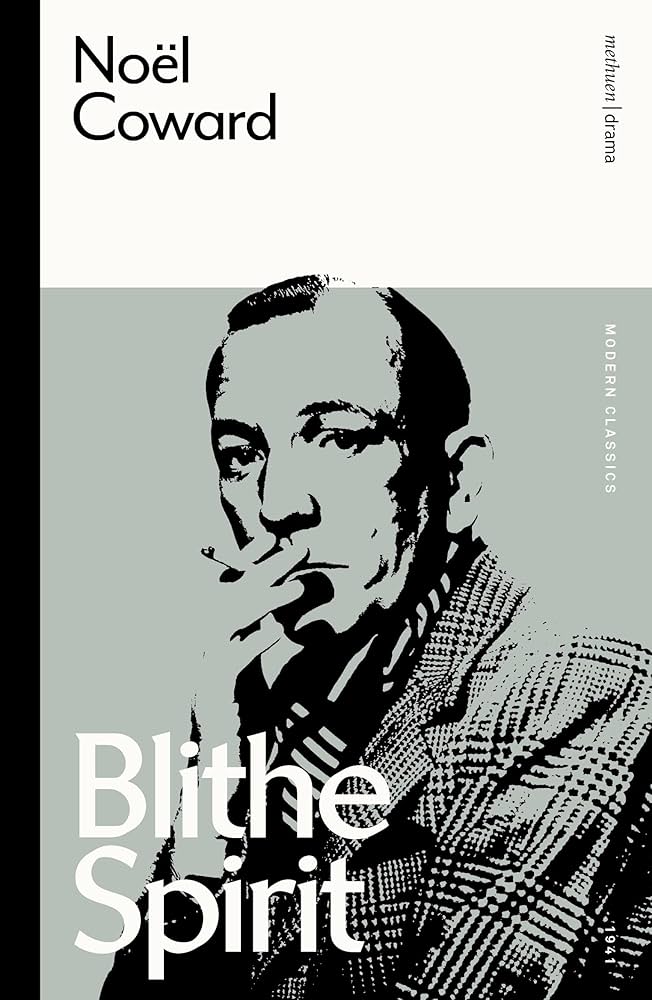| Allison Vincent |

Blithe Spirit plays at the Trylon Cinema from Friday, July 19th, through Sunday, July 21st. Visit trylon.org for tickets and more information.
A foundational memory of mine is sitting in Dr. Doug Julien’s “Comedy Text and Theory” course at the University of Minnesota and realizing the slender thin line that separates a scream from a laugh. Dr. Doug, as he liked to be addressed, told the class he was going to show us an incredibly violent sequence of clips where no fewer than thirteen people were murdered on screen. We sat in stunned silence. He then proceeded to play a YouTube video supercut of the most improbable, unhinged kills from the Friday the 13th franchise. During the first two kills, we were all quietly trying to intellectualize what was going on, but after the 3rd or 4th, some folks in class were openly laughing. By the 7th from Friday the 13th Part VI: Jason Lives, where a man in the woods is thrown into a tree, leaving a bloody imprint of a smiley face in the trunk, we were all cackling. Each ensuing kill made us laugh harder than the last. As the video concluded and tears from laughing rolled down our faces, Dr. Doug asked us, “Why did you all laugh?” The class fell silent again. We didn’t know how to put what we saw and why it was so funny into words.

What Dr. Doug had so brilliantly done was mirror the essential beats that both comedy and horror share: set-up, anticipation/tension, delivery, pay-off/release. Here the setup was him telling us he was going to show us violent footage of murders, then anticipation (or tension, if you prefer) began to build in us as he somberly cued up the video all the way through delivery: the first killing. The pay-off (or release) was us realizing, “Oh, this is Friday the 13th! Wait, did he just punch that guy’s head off?” The release enabled us to laugh. Our expectations of fear, disgust, and dread were subverted into those of delight and relaxation. But, we needed to endure the tension of potentially seeing something grizzly and upsetting to elevate the pay-off of relief from releasing tension. Since that class, I have been fascinated by the way different movies bob and weave along the line between comedy and horror.
Noël Coward is best known for the verbal violence his characters wield against one another rather than, say, a machete. He is a master of the “comedy of manners” style, in which high society is satirized through witticisms, cutting dialogue, copious martinis, and plots generally concerning love triangles, warring couples, affairs, or other such scandals of the upper crust. In Blithe Spirit, Coward brilliantly uses the tension of supernatural situations to create comic release through razor-sharp dialogue. Although the original stage script favors pure comedy over the more occult elements David Lean attempted to feature in the film.
The play premiered during an incredibly scary time in the UK, where death and destruction were a daily concern. It originally opened in 1941, while bomb raids were rocking Great Britain. Coward was very involved in the war effort running the British propaganda office in Paris and the Secret Service while also traveling and performing for British troops around Europe and Africa. The idea of being suddenly blinked out of existence was a constant presence in the psyche of the citizenry. So, Coward turning his wit and his pen to the petty machinations of those stuck in the afterlife might have been an opportunity to give the theatergoers of London permission to laugh at death and some much needed hope that life does indeed continue after death.

The plot begins with the famous author and widower, Charles Condomine, inviting a medium, Madame Arcati, to his house to host a seance. Charles and his second wife, Ruth, host a dinner party before the seance with Madame Arcati and Dr. and Mrs. Bradman. What Madame Arcati doesn’t realize is that she is being asked to perform as research for Charles’s new novel featuring a phony clairvoyant. All the dinner guests assume Madame Arcati to be a quack, however, she manages to accidentally summon Charles’s first wife, Elvira, who is jealous of Charles’s marriage to Ruth. Free from whatever constrained her in the spirit world, Elvira sets out to break Charles and Ruth up, and we’re off to the situational comedy races from there.
Coward makes great usage of comedic misunderstanding when Ruth, Charles, and Elvira are onstage talking to one another, but Ruth cannot hear or see Elvira, who continuously hurls insults at Ruth. Whenever Charles’s reprimands Elvira, Ruth misinterprets his words as being directed towards her.
RUTH: I’m not going to stay here any longer.
ELVIRA: Hooray!
CHARLES: Shut up.
RUTH: [incensed] How dare you speak to me like that!
Classic, funny verbal play.
Coward flexed physical comedy muscles in this script as well. It is a delight watching Rex Harrison switch in and out of conversations between his living and deceased wives, like a juggler keeping all his flaming torches in the air. But my favorite physical bit in both the play and the film is the running gag of Edith, the Condomine maid played by Jacqueline Clark, being unable to walk at a normal pace.
One element that absolutely sells both the comedy and the occult elements of the film is Margaret Rutherford’s incredible performance as Madame Arcati. Both Rutherford and Kay Hammond, playing Elvira, originated their roles in the 1941 stage production directed by Coward. Rutherford commits 110% to the kooky, determined, and wholly earnest medium providing a perfect, and much needed foil to the acerbic, cynicism of the Condomine’s and the Bradmans.

In the seance scene, Rutherford is both comical and captivating as she gesticulates around the Condomine parlor in the flickering firelight casting unnerving shadows against the walls. This seems to be this scene where director David Lean most ardently attempted to temporarily nudge the tone away from straight comedy to something a bit more suspenseful in tone. Lean’s additions of exterior scenes, ghostly manipulations of objects when Elvira is not seen by the camera, and the major change to the final scene of the play (no spoilers here, friends!) all contributed to why Coward, the cast, and critics didn’t initially care for the film during its 1945 release. It was a financial flop both in America and Europe. Coward felt that, although not terrible, Lean had ruined his best play by moving away from the straight comedy of his dialogue to add these more cinematic moments.

Despite Coward’s feelings about Lean’s artistic vision, the film won a special effects Oscar, largely for the ghostly POV shots Lean added, and is now a much adored classic. This mirrors the criticism vs. reality of Coward’s worst critics, many of whom stated that his plays were enjoyable enough, but had such little substance that they would never stand the test of time. Yet, here we are still talking about him in 2024. Who’s laughing now, amiright? As viewers experience the film for the first time, it is easy to see that the marriage of Coward’s incredible comic dialogue, Lean’s brilliant usage of space, light, and practical effects, and the incredible performances of the cast make this film a classic that stands the test of time.
When a movie’s rhythm is in the groove, both comedy and horror subvert our expectations producing either laughter or shrieks. When comedy and horror are at their best, those subversions encourage us to reflect on the film’s themes. They stick with us and gnaw at our own understanding of the world. Coward achieves this in Blithe Spirit because you can’t help but imagine what you might do if you were in Charles Condomine’s shoes despite the absurd situation he finds himself in. It asks a rather large question about love, marriage, loyalty, and the vow “til death do us part.” There is an old theater adage: if you want them to cry at the end, make them laugh at the top. When horror employs comedy and vice versa, the audience is the ultimate beneficiary.

Image Credits
McLoughlin, Tom, dir. 1986. Friday the 13th Part VI: Jason Lives.Film. Los Angeles, CA, USA: Paramount Pictures.
“The Blitz.” Historic UK, December 9, 2023. https://www.historic-uk.com/HistoryUK/HistoryofBritain/The-Blitz/.
Blithe Spirit. London, NY: Two Cities Film production company ; Distributed by Learning Corp. of America, 1945.
Blithe Spirit. London, NY: Two Cities Film production company ; Distributed by Learning Corp. of America, 1945.
Coward, Noël, and Arianne Johnson Quinn. Blithe Spirit. London: Methuen Drama, 2023.
Edited by Olga Tchepikova-Treon
